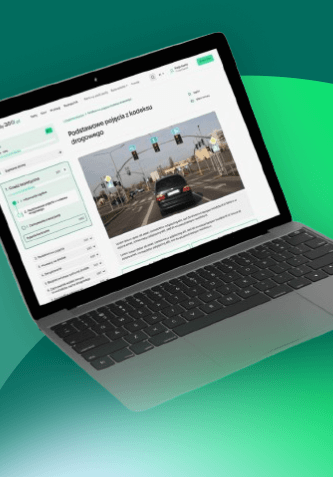Demo version, buy access to use the full eBook.
Purchase access
Driving License eBook - demo
Buy access to fully use the entire functionality of the student’s eBook for all categories.

The student's eBook contains.:
- The student’s eBook is an innovative method of preparing students for the theoretical driving license exam. It saves time as users can study whenever and wherever they have a free moment.
- You do not have to strictly adhere to a predetermined lecture plan, as our eBook allows the course to be conducted anywhere, for example, during a commute, and additionally, you can always go back to the material already covered to reinforce it.
- The student’s ebook is very clear and easy to navigate. It consists of 14 diverse sections, each followed by 10 control questions that must be answered correctly. This allows the student to verify whether they have sufficiently absorbed the material covered in the given thematic section.
What do the individual sections contain? individual departments?
Section 1
Theoretical part
This section contains general information about various driving license categories and basic concepts from the traffic code, such as:
- Confiscation of the registration certificate.
- Confiscation of the driving license.
- Loss of the driving license.

Section 2
Road signs and traffic signals
It contains the most important information about road signs and traffic signals, for example:
- Priority hierarchy.
- Warning signs.
- Police officer’s gestures.

Section 3
Intersection of traffic directions
This section provides knowledge about types of intersections:
- Equal-priority intersections.
- Roundabouts.
- Intersections controlled by an authorized person.

Section 4
Vehicle movement
- available for free
This section covers, among other things, vehicle movement and behavior on the road. Among other things, you will learn:
- What is a residential area?
- How to merge into traffic?
- How to maintain a safe distance?

Section 5
Order and safety on the road
In this section, you will find information about behavior and safety, such as:
- Using external lights.
- Signaling vehicle damage.
- How to transport cargo safely.

Section 6
Behavior towards pedestrians, cyclists, railway, and tram crossings
This section teaches proper behavior towards:
- Pedestrians.
- Cyclists.
- Rail vehicles.

Section 7
Special caution
In this section, you will learn concepts such as:
- Caution and special caution.
- Limited trust.
- Insufficient visibility.

Section 8
Providing pre-medical first aid
In the section on first aid, you will find information about:
- How to behave during an accident.
- How to provide first aid.

Section 9
Intoxicants and the influence of alcohol while driving
In this section, you will learn how the following affect the driver:
- Alcohol.
- Intoxicants.

Section 10
Speed limits
This section informs about:
- Permissible speeds.
- Safe distance.
- Braking.

Section 11
Driving technique
The information contained provides knowledge about driver behavior during:
- Driving in difficult weather conditions.
- Driving with a trailer.
- Behavior during overtaking.

Section 12
Driver responsibilities
In this section, you will learn:
- What are the responsibilities of a vehicle owner?
- What insurance is mandatory?

Section 13
Vehicle construction
In this section, you will learn:
- The basic elements of vehicle construction.
- Types of support systems.
- Vehicle indicators

Section 14
Appendix
The final, additional section contains useful information about:
- Eco-driving.
- Vehicle inspection.
- Practical exam.





